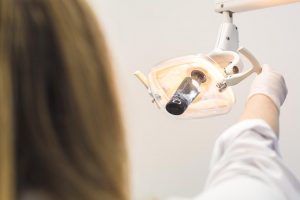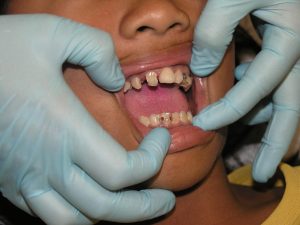
Whether used to restore a damaged tooth or to create a lifelike tooth replacement for an implant, crowns can be fabricated in dental laboratories or in your dentist’s office, depending on the material.
Part of your consultation may involve taking impressions of your teeth as a basis for creating the shape and size of your restoration(s). Crowns can also be used as part of a smile makeover in order to change the length, shape and alignment of your teeth
Your treatment usually involves placement of a temporary crown. Your dentist will advise you on how long you will need to have the temporary in place and what hygiene steps to take to ensure functionality.
If you, your family or friends need dental care, we would be honored to provide you with state-of-the-art dental care in our modern dental practice. Refer someone you love to someone you trust!
Presented as a service to the community by Doctors Hoover and Yanda,
39 Milford Drive, Hudson, Ohio 44236. 330-650-0360. www.drshooverandyanda.com

 When your treatment plan calls for direct composite restorations or adhesively bonded restorations, dentists start the process by isolating the teeth, to prevent interference from moisture. Depending on the extent of the treatment, anesthetic injections may be required.
When your treatment plan calls for direct composite restorations or adhesively bonded restorations, dentists start the process by isolating the teeth, to prevent interference from moisture. Depending on the extent of the treatment, anesthetic injections may be required. The term bonding is used in dentistry to describe adhering dental materials to your teeth using specialized adhesives and a high-intensity curing light.
The term bonding is used in dentistry to describe adhering dental materials to your teeth using specialized adhesives and a high-intensity curing light. To determine if your dental problems can be solved with direct composite bonding, your dentist first will conduct a thorough examination and evaluation of your teeth and gums. During your consultation, your dentist will discuss the clinical and cosmetic problems that direct composite bonding can resolve, such as cavities, chips, cracks, fractures, gaps and spaces between teeth, and tooth discoloration. However, if you have teeth that are extensively damaged or your dentist feels other dental issues may affect the success and longevity of direct composite bonding treatment, other options may be presented to you, such as crowns or veneers.
To determine if your dental problems can be solved with direct composite bonding, your dentist first will conduct a thorough examination and evaluation of your teeth and gums. During your consultation, your dentist will discuss the clinical and cosmetic problems that direct composite bonding can resolve, such as cavities, chips, cracks, fractures, gaps and spaces between teeth, and tooth discoloration. However, if you have teeth that are extensively damaged or your dentist feels other dental issues may affect the success and longevity of direct composite bonding treatment, other options may be presented to you, such as crowns or veneers. Enamel loss is a common component of tooth decay and may result in tooth sensitivity. In many cases, sensitivity caused by enamel loss will be significantly improved or completely eliminated once an appropriate dental filling material is placed.
Enamel loss is a common component of tooth decay and may result in tooth sensitivity. In many cases, sensitivity caused by enamel loss will be significantly improved or completely eliminated once an appropriate dental filling material is placed. Composite fillings are usually more expensive than traditional amalgam fillings because they require a more sophisticated process, more expensive materials and additional office equipment. Composite materials offer an aesthetic alternative to traditional amalgam materials. Because composites can be bonded to teeth, they provide a better seal against leakage and further decay. As such, people who have previously received amalgam fillings often return to their dentist to have them replaced with composite.
Composite fillings are usually more expensive than traditional amalgam fillings because they require a more sophisticated process, more expensive materials and additional office equipment. Composite materials offer an aesthetic alternative to traditional amalgam materials. Because composites can be bonded to teeth, they provide a better seal against leakage and further decay. As such, people who have previously received amalgam fillings often return to their dentist to have them replaced with composite. Composite fillings are usually more expensive than traditional amalgam fillings because they require a more sophisticated process, more expensive materials and additional office equipment. Composite materials offer an aesthetic alternative to traditional amalgam materials. Because composites can be bonded to teeth, they provide a better seal against leakage and further decay. As such, people who have previously received amalgam fillings often return to their dentist to have them replaced with composite.
Composite fillings are usually more expensive than traditional amalgam fillings because they require a more sophisticated process, more expensive materials and additional office equipment. Composite materials offer an aesthetic alternative to traditional amalgam materials. Because composites can be bonded to teeth, they provide a better seal against leakage and further decay. As such, people who have previously received amalgam fillings often return to their dentist to have them replaced with composite. One of the more common oral health issues discovered during scheduled cleanings is dental caries (tooth decay). Your dentist will examine your teeth using a dental instrument called an explorer and may also take an X-ray to determine the extent and exact location of the cavity and decay. In our office, we also use a laser to help detect decay.
One of the more common oral health issues discovered during scheduled cleanings is dental caries (tooth decay). Your dentist will examine your teeth using a dental instrument called an explorer and may also take an X-ray to determine the extent and exact location of the cavity and decay. In our office, we also use a laser to help detect decay. Always ask your dentist if you’re not sure how your nutrition (diet) may affect your oral health. Conditions such as tooth loss, pain or joint dysfunction can impair chewing and are often found in elderly people, those on restrictive diets and those who are undergoing medical treatment. People experiencing these problems may be too isolated or weakened to eat nutritionally balanced meals at a time when it is particularly critical. Talk to your dental health professional about what you can do for yourself or someone you know in these circumstances.
Always ask your dentist if you’re not sure how your nutrition (diet) may affect your oral health. Conditions such as tooth loss, pain or joint dysfunction can impair chewing and are often found in elderly people, those on restrictive diets and those who are undergoing medical treatment. People experiencing these problems may be too isolated or weakened to eat nutritionally balanced meals at a time when it is particularly critical. Talk to your dental health professional about what you can do for yourself or someone you know in these circumstances. You may be able to prevent two of the most common diseases of modern civilization, tooth decay (caries) and periodontal (gum) disease, simply by improving your diet. Decay results when the teeth and other hard tissues of the mouth are destroyed by acid products from oral bacteria. Certain foods and food combinations are linked to higher levels of cavity-causing bacteria. Although poor nutrition does not directly cause periodontal disease, many researchers believe that the disease progresses faster and is more severe in patients whose diet does not supply the necessary nutrients.
You may be able to prevent two of the most common diseases of modern civilization, tooth decay (caries) and periodontal (gum) disease, simply by improving your diet. Decay results when the teeth and other hard tissues of the mouth are destroyed by acid products from oral bacteria. Certain foods and food combinations are linked to higher levels of cavity-causing bacteria. Although poor nutrition does not directly cause periodontal disease, many researchers believe that the disease progresses faster and is more severe in patients whose diet does not supply the necessary nutrients.